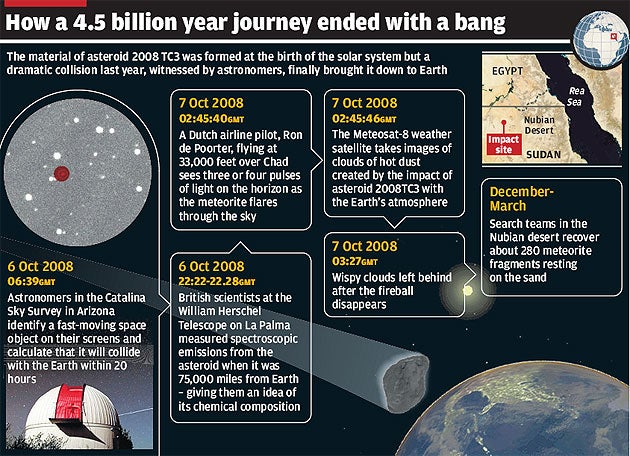How scientists caught an asteroid
Astronomers are there to pick up pieces after space rock 'the size of a lorry' explodes entering Earth's atmosphere

For the first time, astronomers have tracked an asteroid in space in the hours immediately before it collided with the Earth's upper atmosphere in a dramatic explosion.
The 80-tonne object – known as 2008TC3 – was the size of a small lorry and was spotted by astronomers on 6 October 2008.
Just 20 hours later it exploded with the force of about 1,000 tonnes of TNT 41 miles above the Nubian desert of Sudan, scattering fragments of meteorites across north-east Africa.
As soon as it was realised that the asteroid was on a collision course with Earth, astronomers from 26 observatories across the world scrambled to ensure that their instruments gathered as much information on it as possible before it was almost completely vaporised in the explosion.
The scientists not only managed to predict precisely when and where the collision would take place, but they also recovered nearly 280 pieces of the meteorite for chemical analysis. "This was an extraordinary opportunity, for the first time, to bring into the lab actual pieces of an asteroid we had seen in space," said Peter Jenniskens of Nasa's Seti Institute in California.
"This asteroid was made of a particularly fragile material that caused it to explode at a high altitude, before it was significantly slowed down, so that the few surviving fragments scattered over a large area. The recovered meteorites were unlike anything in our meteorite collection up to that point," Dr Jenniskens said.
The fragments revealed that it was made of material that formed at the birth of the solar system more than 4.5bn years ago, but that the 12ft-wide asteroid itself had probably been created in a cosmic collision in the asteroid belt about 2 million years ago, said Professor Alan Fitzsimmons of Queen's University Belfast, an author of the study published in the journal Nature.
"This is the first-ever predicted impact of an asteroid with the Earth and the very first time an asteroid of any size has been studied before impact," Professor Fitzsimmons said.
Professor Richard Crowther of the Government's Science and Technology Facilities Council said that not all asteroid impacts were as harmless as this one and that the knowledge gained with 2008TC3 will help to mitigate the potential impact of much bigger collisions that could occur in the future.
Join our commenting forum
Join thought-provoking conversations, follow other Independent readers and see their replies
0Comments